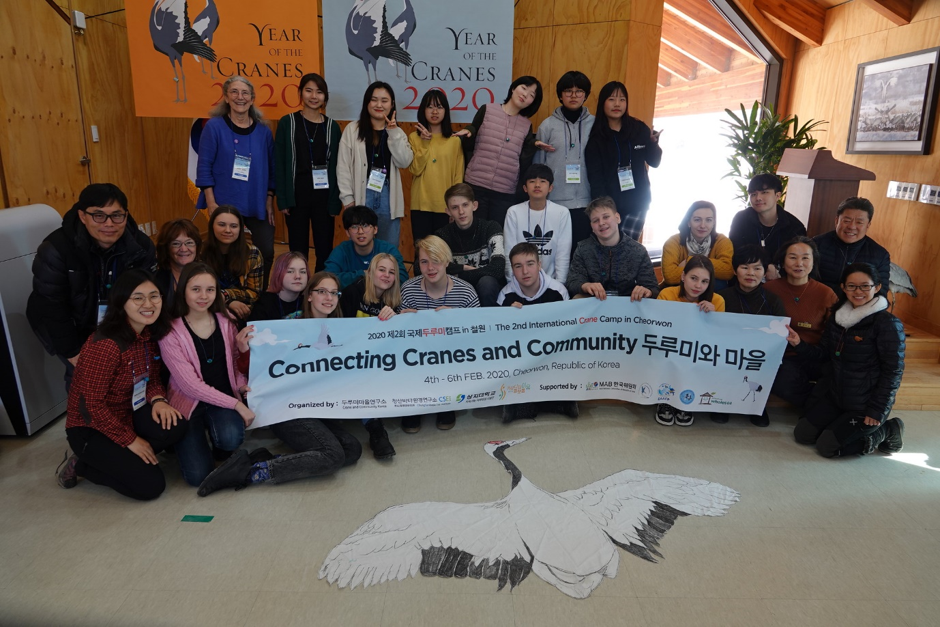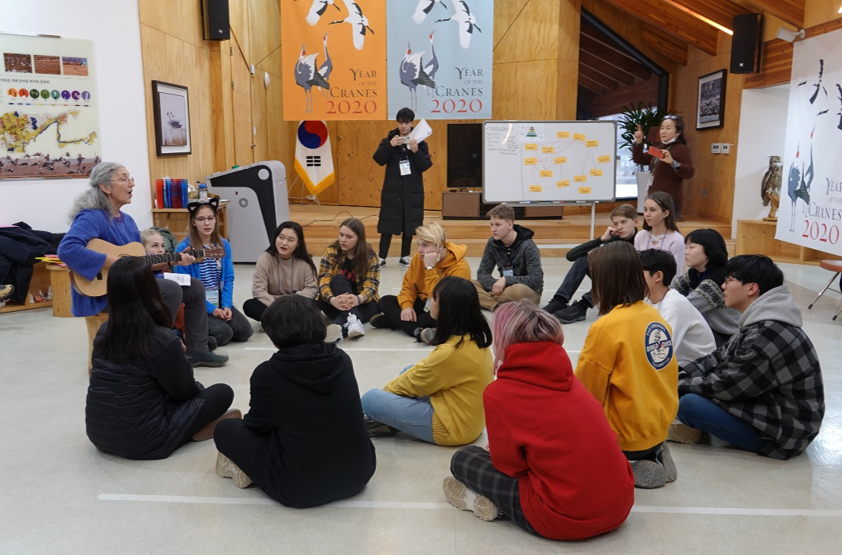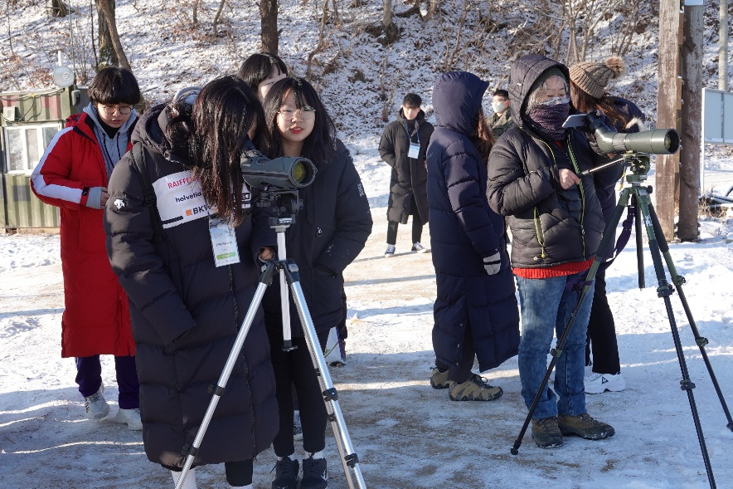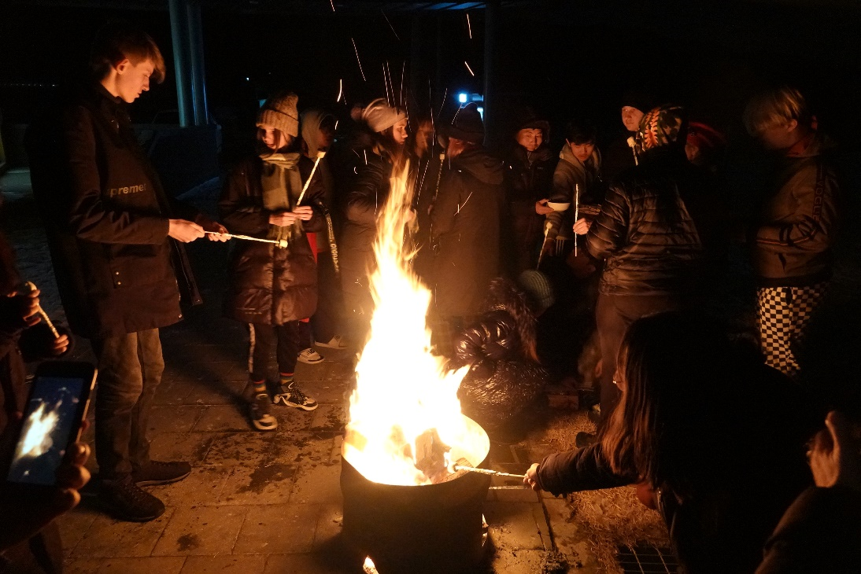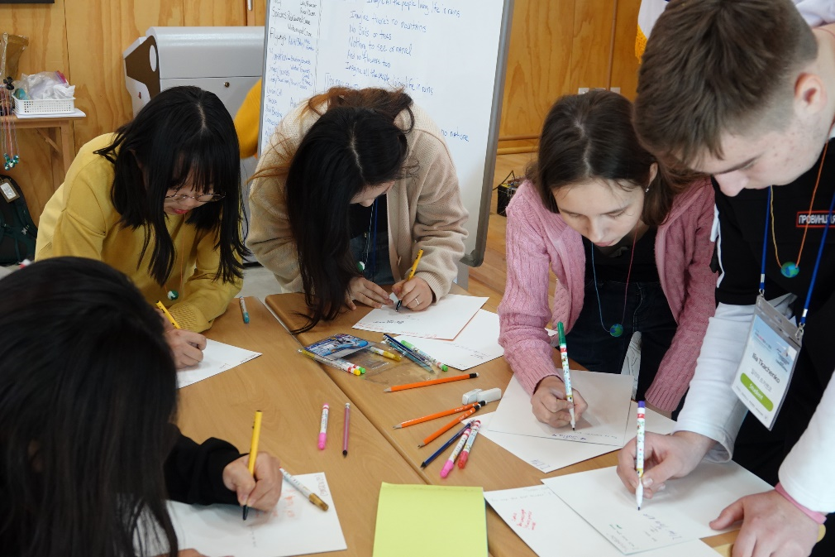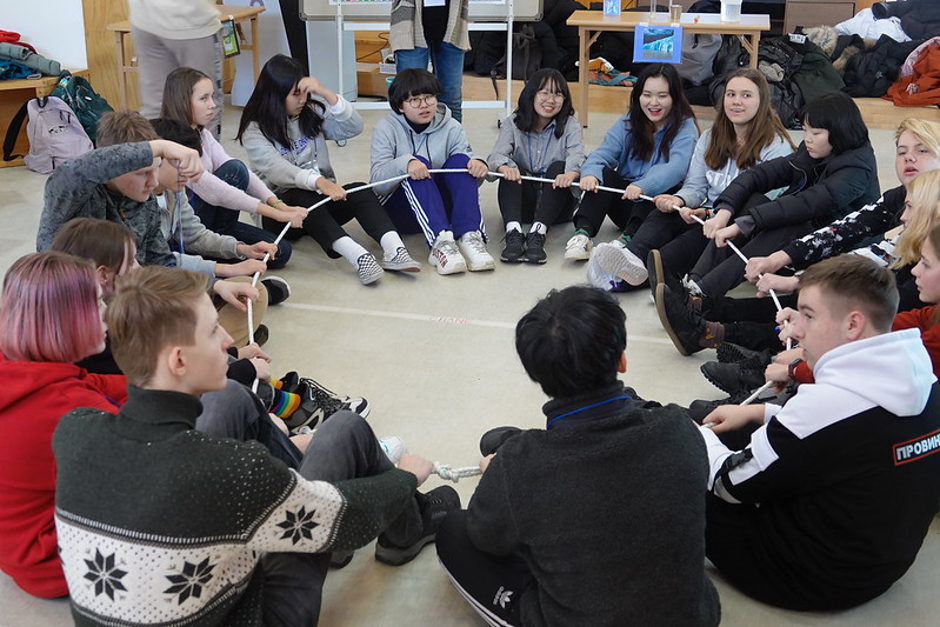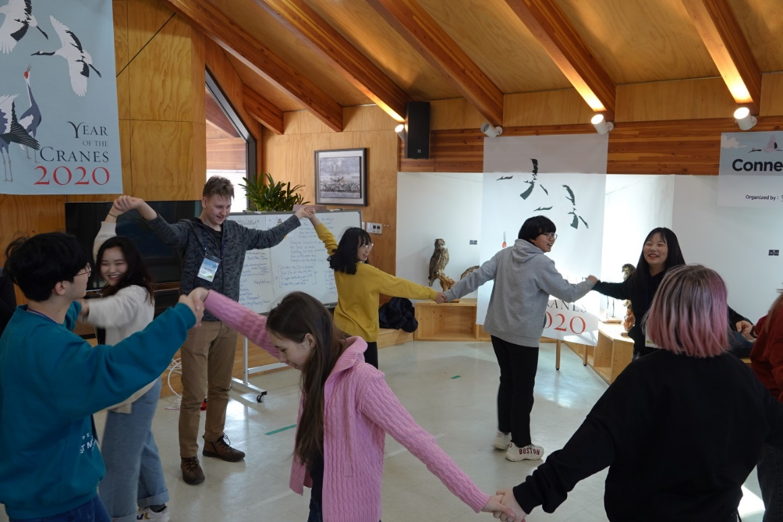* Please scroll down for Russian version
In celebrating the Year of the Crane, the enchanting 2nd International Crane Camp took place from 4th to 6th February, 2020 in Cheorwon, Ro Korea, aiming to educate and linking students from breeding and wintering sites of the cranes in North-east Asia.
This year, there were a total of 17 students joined the camp, with 10 Russian students and 7 Korean students. This three-day camp was instructed by two experienced environmental educators from the United States, Ms. Sharon Hushek and Ms. Susan Grace and one teacher from Russia, Ms. Kseniia Pudova. In the camp, students from the breeding site of the cranes met students from where the cranes spent their winter, and learned about the beauty of the crane, the relationship between these sites and the importance to protect them in English. The Crane camp was organized by Crane and Community Korea, CheongSanbada Eco Institute (CSEI ), and Sangji University with generous support from Korea UNESCO MAB Committee, International Crane Foundation (ICF), Muravioka Park, and EAAFP.
Day 1
On our first day, with unexpected snow welcoming all the participants to Cheorwon, the 2020 2nd International Crane Camp in Cheorwon was launched with the greetings of all the participants. The “Crane Camp” began with lectures from Dr. Kim Kyungwon about the ecology of cranes, Ms. Vivian Fu, Communication Officer of EAAFP shared on the linkage of migratory waterbirds to countries and people in the region. In addition, Ms. Kseniia Pudova shared the beauty of Russian nature.
After that, the class began. The students were split into two classes; they played games to know each other. Susan and Sharon made the classes fun by introducing hands-on activities for students to understand different terms and concepts about ecology through observations, songs, and games, where the students were able to blend and associate themselves with these concepts about nature.
Day 2
Early in the morning, the class visited the Togyo Reservoir for crane watching. It is the night roosting site for thousands of waterbirds including cranes, ducks and geese. All participants were amazed by the scene when the birds flew over towards their feeding ground. While watching the birds, Dr. Kim explained to the students about the life of cranes by interconnecting them with the students. After the morning class to understand ecosystem service of wetlands, the students visited the HanTan River where they were able to observe the cranes, swans and other waterbirds more closely with binoculars and telescopes and even enjoyed the callings from juvenile cranes.
Back to the class, Ms. Susan and Ms. Sharon brought more inspiring games for learning about water cycle and discussion on conservation management. These activities allowed students to experience and connect themselves to the cranes and nature which they just saw in the wild.
At the “Friendship Night”, all participants gathered around the warm campfire to sing songs, to play and to enjoy the sweetest S’mores, roasted Jjondeukgi (Korean junk food) and roasted sweet potatoes.
Day 3
It was sad that the last day of school came! The last day was still filled with fun games for students to learn about the threats faced by migratory cranes. The class ended with a silent and reflective moment called “Council of all being”, in which everyone imagined themselves as a creature in nature and deliver a message to the world.
As the crane school came to an end, all students became close with each other, breaking the linguistic and cultural barriers. Even though they have been physically tired, their minds seemed to become stronger within their amazing and reflexive time in Cheorwon Crane Camp.
The Cheorwon Crane Camp closed with a marvelous ceremony, where each student presented their prepared poems and Instagram statements as the message they brought for this crane camp. Near the end of the ceremony, Korean students and Russian students received their certificates and students, teachers, volunteers and EAAFP shared their prepared gifts with each other. Korean and Russian students also promised to meet again at the environmental camp in Muraviovka Park, Russia in June.
After this camp, it became more evident how enchanting it was to observe the power of nature uniting people from different places. Cheorwon Crane Camp presented unforgettable memories for the students as well as for all the participants. Additionally, with the support from the local people of Cheorwon, who served all the meals and checked all participants’ health condition, the camp was successful! We once again hope for the future cooperation for the 3rd Cheorwon Crane Camp and could expand to have students from China, Mongolia and Japan to join too!
Click [here] for photos of the 2ndInternational Crane Camp of Cheorwon.
Второй международный журавлиный лагерь в Чеорвоне 2020
Отмечая Год Журавля, свои двери во второй раз распахнул журавлиный лагерь в Чеорвоне, Южная Корея, объединив студентов с территорий гнездования и зимовки журавлей на территории Северо-восточной Азии.
Смена проводилась с четвертого по шестое февраля 2020 в городе Чеорвон, Южная Корея.
В этом году в лагере собралось 17 студентов: 10 из России и 7 из Южной Кореи. Трехдневная смена проводилась двумя опытными преподавателями из США, Шэрон Хашек и Сьюзан Грэйс, а так же учителем из России, Ксенией Пудовой. В лагере ребята из региона гнездования журавлей встретились со своими сверстниками, живущими в месте зимовки птиц, и на английском языке узнали взаимоотношениях между этими регионами, о красоте этих замечательных птиц, о важности их защиты.
Организаторами смены в лагере стали сообщество Crane and Community Korea, Экологический институт CheongSanbada (СSEI), Университет Sanggji при поддержке ЮНЕСКО в Корее, Международный журавлиный фонд (ICF), Муравьевский парк устойчивого природопользования, а также Восточно-азиатское, австроазиатское сообщество, занимающееся вопросами миграции птиц в данных регионах (EAAFP).
День 1
В первый день участников смены встретил довольно неожиданный снегопад.
Открытие смены Второго журавлиного лагеря началось с приветствий и знакомств с участниками. Доктор Ким выступил с лекцией об образе жизни и охране журавлей, мисс Вьвьен Фу, специалист по связям с общественностью в EAAFP, подробно рассказала о миграции птиц и влиянии людей на этот процесс. Также, Ксения Пудова выступила с презентацией, рассказывающей о красоте российской природы.
Сразу после начались занятия. Ребят поделили на две группы; они играли в игры на знакомство. Сьюзан и Шерон сделали занятия веселыми, разнообразив их всевозможными интерактивными заданиями, позволившими узнать и понять различные термины посредством наблюдений, песен и игр, где студенты сами смогли представить себя на месте какого-нибудь животного или иного объекта природы.
День 2
Рано утром класс отправился на водохранилище Токйо для наблюдения за птицами. Водохранилище – место ночёвки тысяч водоплавающих птиц, включая журавлей, гусей и уток. Все были абсолютно поражены моментом, когда десятки и сотни птиц взлетали с мест ночёвки, чтобы раздобыть себе еду. В это время доктор Ким рассказывал студентам, как устроена жизнь журавлей в регионах их зимовки. Позже ребята отправились на берег реки Хантан, где смогли понаблюдать за журавлями, лебедями и другими птицами с более близкого расстояния, используя бинокли и телескопы, и даже смогли услышать, как кричат маленькие журавли.
По возвращении в класс, Сьюзан и Шерон провели несколько игр, направленных на изучение круговорота воды в природе, а так же охраны природы. Эти занятия позволили ребятам прочувствовать и связать себя с журавлями и окружающей средой, которую ранее они увидели в диких условиях.
После «Вечера Дружбы» все участники собрались у теплого костра, пели песни, играли, наслаждались сморсами, жаренным сладким картофелем.
День 3
Было грустно осознавать, что третий день был последним в смене этого лагеря. Однако в этот день ребята снова играли в игры, где узнали об опасностях, которые поджидают птиц во время миграции. Занятия подытожил «Совет всех существ», на котором каждый представлял себя тем или иным творением природы и обратился ко всему миру с посланием.
Благодаря смене в журавлином лагере студенты стали ближе друг к другу, сломав языковые и культурные барьеры. Не смотря на физическую усталость, все участники смены были преисполнены эмоциями и новыми знаниями, приобретенными в лагере.
Завершала смену чудесная церемония, где каждый участник рассказал свои стихи и тексты для постов в Инстаграм, как сообщение, которым они подытожили смену в лагере.
Корейские и российские студенты обменялись подарками, а так же получили сертификаты об участии во втором международном журавлином лагере.
Ребята также пообещали встретиться снова, уже в Муравьевском парке, в июне 2020.
После проведения смены стало ещё более очевидно, как прекрасно наблюдать за природой, объединяя людей из разных стран и регионов. Журавлиный лагерь в Чеорвоне подарил незабываемые воспоминания всем участникам. Также хочется отметить поддержку местного населения. Благодаря им, питание участников смены было на высочайшем уровне и несомненно очень полезным! Мы надеемся снова собраться, уже на третьей смене лагеря, где сможем расширить границы, пригласив участников из Китая, Монголии и Японии!

